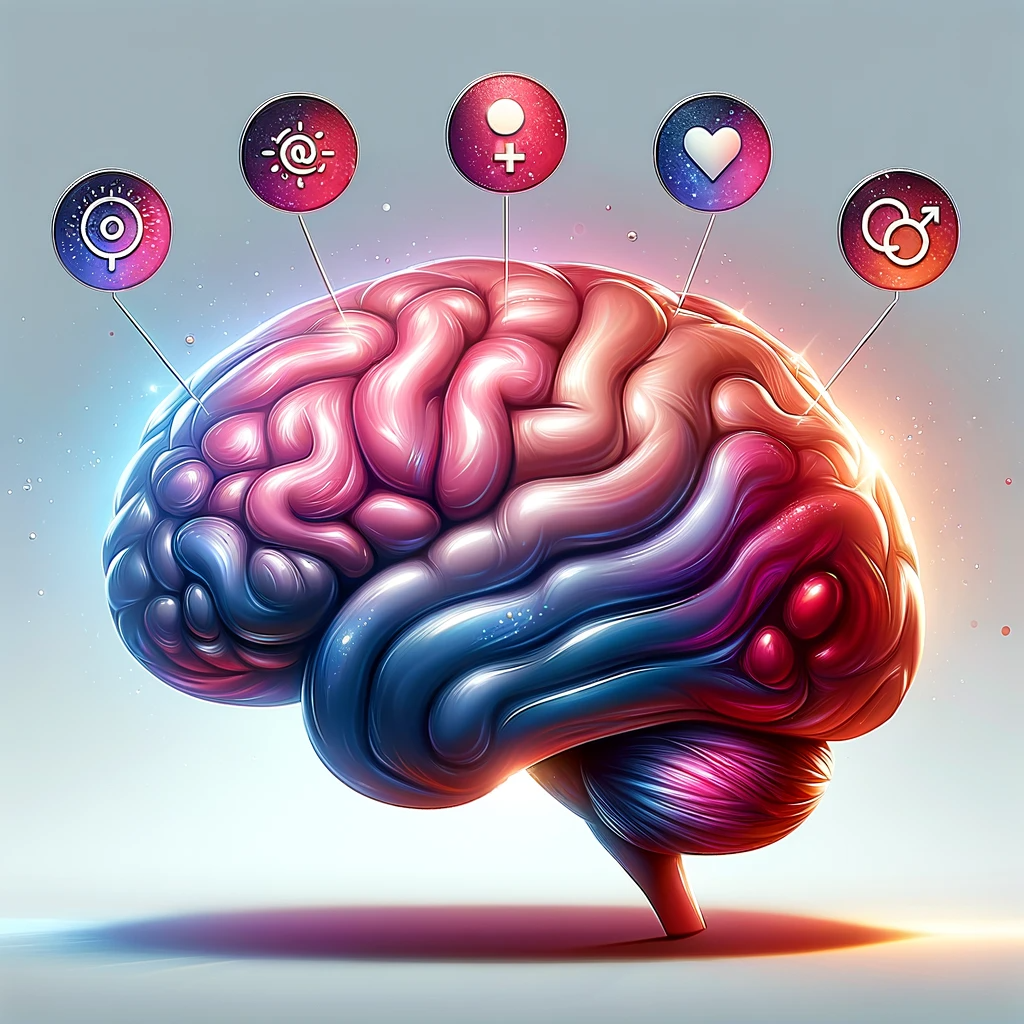We can see it in retrospect. Later in the evening, once we are home from work, thinking over a conversation or an email or a meeting, we can tell we got hooked. Went down the path of showing how we were right, explaining the process, anticipating potential retorts and fending them off, maybe even getting a little heated in the process. We got in our own way and derailed whatever our original intent was. With the passage of time and distance, it’s all so clear. The trick is to notice it the moment it happens, maybe even before the moment so that we don’t get caught in that trap again.

As inclusive leaders, we must develop our own emotional intelligence and our own bodily awareness so we can catch moments before they become real. To notice changes in our thoughts or in responses within our body before they become words or actions.
Sometimes it can look like this, where the leader begins to
- Argue what doesn’t need to be argued, anticipating disagreement that isn’t there
- Double down on a bad choice
- Disagree not with the idea but because of the person saying it
- Justify a decision at great length
Not only are these bad situations as the leader, but they can lead to a toxic work environment, one where people are afraid to contribute their ideas. It shuts down discussion and therefore innovation.
Part of developing our internal mechanism is noticing the earliest signs of when we are getting caught up so that we can pause. Because our brains are constantly trying to protect us from threat, our brains jump to conclusions before we even notice. In the workplace, our brains might see a threat where there isn’t any and begin to react. Our job is to start noticing. Noticing our own patterns, our responses, our thoughts and our body sensations so we can interrupt this pattern.
What is JADE and Why Does it Matter?

There’s an acronym to help us out with noticing our thoughts and words: JADE (Justifying, Arguing, Defending and Explaining). When we find ourselves doing these things in the workplace, it’s a sign to pause and refocus. This idea first came through Alanon circles, but as in most things, tools that are useful in our personal lives are also applicable in our professional ones.
As you read, see if you recognize yourself. Try to recognize both an obvious time and the most subtle – the moments when it is absolutely clear that we are operating from this place and the moments when we are getting the first hints of it. Take the time to reflect on these situations. Notice if they are habitual behavior or if there are specific situations or circumstances where JADE seems to happen more frequently.
J: Justifying. In any decision, people have their reasons. Listing our reasons at length, especially when no one has asked for them, is unnecessary. We have all read that email, the one that is too long with many bullet points that spells out all the minutiae behind a decision. As a recipient, we probably never finished reading it, at some point thinking “just tell me what the decision is already, I don’t need the play-by-play.” Feeling the need to justify at length is a sign that our work culture is not inclusive–that people (including ourselves) don’t have enough trust and respect already built-in. We believe that others might be adversarial and try to pre-empt them with our well thought-out reasons. When a group has been appropriately included in a process and a team has good communication, decisions can simply be announced. Those who have further questions or need more information know that it’s ok to ask. Justifying is a way we try to fend off a potential attack. When we find ourselves going there, or more importantly, wanting to go there, we must pause. Take a minute away from the situation. We can ask ourselves, “How can I say less here?” and then “How can I say even less than that?”,giving ourselves multiple opportunities to strip away justifications.
A: Arguing. This one seems more straightforward, but we might not notice when a conversation has turned into an argument until we are well in the middle of one. Also our standards for what constitutes an argument might be different—our argument might be someone else’s ordinary conversation. It’s important to differentiate arguing from disagreeing. Disagreement is allowed and important for getting multiple points of view. But when we find ourselves, whether verbally or in our head, experiencing any name-calling, rudeness, personal attacks, or in general a feeling of wanting to win, it has probably moved from a disagreement to an argument. That transition means a conversation has moved from something that is productive to something that is a waste of everyone’s time. As a leader, if we are the person arguing, it shows everyone we work with that it is not safe to offer up their opinion, that any question from us is rhetorical and that we don’t want feedback. In addition to noticing signs of rudeness in our thoughts, arguing is more likely to have physical sensations that we might notice. As a conversation gets heated, so do we. Knowing what happens in our bodies when we start to flip to argue mode is critical to recognize. It will be slightly different for everyone although it involves speeding up with increased heart rate, faster speech, getting hotter in your body. Recognizing the earliest signs in ourselves will help us to pause and to write that email or slack later, to ask someone else to read what we’ve written, to pause a part of the agenda and return to it later, to take a five minute break in the conversation, to do anything that allows a pause to reset. As the leader, we also have to consider everyone in the presence of arguing because when people are around arguing they either join in, check out or shut down. Each category requires different strategies to re-engage, but in all cases, a pause will help to get started.
D: Defending. This response is a tricky one because it’s a natural reaction. When we feel attacked we get defensive–it’s our fight response, after all. We are hard-wired to defend ourselves. While it’s ok to feel defensive, it’s not ok to act from that place. This is a perfect moment to practice the pause. Listen to the thoughts in our head. If we suddenly stop listening to the conversation and our mind is filled with all of our many good thoughts, jabs and barbs, we might be getting defensive. If we feel ourselves wanting to say something sarcastic, that could be defensiveness creeping in. Or even more simply, listen for the But in our heads. If we hear ourselves wanting to start our response with “Yes, but” that’s a strong sign that we are operating from a place of defensiveness. No good can come from this because it sets up an automatic wall when we are defending we are not listening and it’s likely to make other people defensive as well. We are at minimum trying to protect ourselves and possibly trying to win. When we hear the But, it is a sign to change from defensiveness to curiosity, to open up and get as curious as possible about the situation we face. And if we aren’t curious, we need to wait until the curiosity arrives.
E: Explaining. Now, wait a minute! Even explaining things is a bad idea? People deserve explanations, so they don’t think I’m making decisions arbitrarily. How can it be inclusive not to explain? Point well taken, but let’s tease out the nuances of this.. First off, we aren’t saying to make decisions alone or make top-down decisions. Let’s assume that decisions are made with input from the appropriate people, that considerations have cycled through at least the 5 cognitive bias checklist, and we have included a wide range of perspectives, including those most impacted by the decision. If that is true, once the decision is made, there is no need for an explanation. Yes, a brief summary is ok, but when we find ourselves in an extended back and forth, fielding extensive clarifying questions, it’s time to get out of that conversation. We are then in a dynamic that is more about the back and forth than about the actual decision. When we find explaining, we can imagine ourselves not explaining. It could be that simple. Or maybe we pause, step back and rethink how we got there.
When Others Are JADE-ing
These behaviors are not exclusive to leaders, anyone in the organization might have JADE as a pattern for themselves. When we are noticing these behaviors in our colleagues or in our direct reports, it is an opportunity for us to pause and think about how to approach the situation. We learn these behaviors in the workplace for a reason. Sometimes it’s simple – we like to be right and love to argue for argument’s sake. Other times, these JADE tendencies come from having previous toxic experiences in the workplace – they have been our survival mechanisms. If we have had experiences of not being trusted, of being treated as other, of having to do twice as much to get half as far, of being micromanaged and questioned, we might start to have those arguments, explanations and defenses ready at all times. In these instances, as an inclusive leader, it can be helpful to have some grace and to point out to our colleague that we trust them, and we trust their decision. That their Yes or No is enough and that if we had questions or wanted to hear more, we would ask them. There are ways to consistently indicate that we trust their work and that we do not need their explanation. If it’s a pattern, they might not even realize they do this, or that it is anything other than helpful.

Above all else, as inclusive leaders we want to make sure we aren’t creating the conditions for JADE behaviors to flourish. We don’t want to be the toxic workplace that people need to recover from. Consider the culture of your organization or your team dynamics. Who might feel “other” or the “only” in the group? There are probably multiple people this will apply to, whether they are the most recent hire or the only woman, the only Asian, the only person over 60, the only person with a disability, the only Muslim-we can see how this list has many possibilities. The modern workplace is incredibly contextual. There are circumstances where you may be the “other” and not even know it. As the leader, it’s important to use your position and perspective to step back and look across the organization. Is this person being micromanaged? Or treated like they need to prove themselves in ways that others don’t? JADE might not be something they brought to the workplace but something they learned in your workplace. When in doubt, we need to double down on the practices that build belonging, with a focus on our interpersonal interactions and a reflective look at our everyday procedures and systems in the workplace.

Percipio Company is led by Matthew Cahill. His deep expertise in cognitive, social, and workplace biases is rooted in the belief that if you have a brain, you have bias®. He works with executives to reduce mental mistakes, strengthen workplace relationships & disrupt existing bias within current HR processes, meeting protocols and corporate policies. Matthew has demonstrated success with large clients like LinkedIn, Salesforce and dozens of small to mid-size companies looking to create more inclusive workplaces, work smarter, generate more revenue and move from bias to belonging®.





